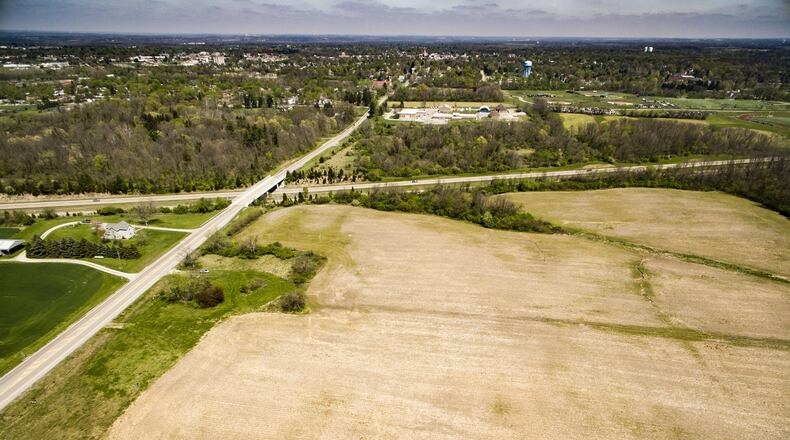The sites were unveiled recently on a new website, OhioCertifiedSites.com, meant to direct large industrial companies to the locations within the 24-county DP&L service area that the utility says are ripe for building and business.
Tom Tatham, director of operations for DP&L, has been with the company for more than 30 years. Although the website is new, the utility’s economic development efforts really aren’t, he said.
“As an electric utility, it’s an investment in the region,” Tatham said. “If the region succeeds, we succeed.”
Tatham cited the region’s fastest growing manufacturer, Moraine’s Fuyao Glass America, as a prime example.
Chinese industrialist Cho Tak Wong bought the former General Motors plant in the spring of 2014. Drive down that part of Ohio 741 today, and you can see the transmission lines DP&L extended to the plant from a newly built sub-station on Fuyao property, all built in response to Fuyao’s needs.
DP&L invested about $3 million in the Fuyao site, between transmission and substation infrastructure, Tatham said.
When businesses look for sites, he said: “They want to move, and they want to move fast.”
Julie Sullivan, vice president of development for the Dayton Development Coalition, agreed power utilities are already in the development business, whether they acknowledge it or not.
“It’s just another entry point for potential projects, just like an end user or a consultant may call the coalition,” Sullivan said.
In fact, companies looking to expand may make their first call to a utility or a freight transportation company, she said.
Companies want to know about electric and gas service, Tatham said. They have questions about location, develop-able acreage, proximity to interstates and highways, zoning, water, sewer and more.
“You either have to have those in place, or you have to have a plan to get them in place in a reasonable amount of time,” Tatham said.
“In a lot of ways, they can be an intake point,” Sullivan said of utilities. “They’re definitely a partner in economic development. And we can’t do what we do without them.”
Companies considering expansion or a move to the Dayton area want details about possible sites, she said. And they’re “inherently risk-averse,” looking for tools to make their next move more certain.
Certified sites are a way to do that, Sullivan said.
“Certification” represents a certain level of readiness for development. “It confirms all of the details about a site,” Sullivan said.
DP&L’s current sites include two industrial parks in the Sidney area, another two in Xenia, one on the northern Dayton-Huber Heights border, another in Washington Court House and one in Fayette County. In time, the list may grow.
Georgene Hall Dawson, DP&L manager of customer accounts, said the sites were chosen with local leaders in each community, with local talks starting in late 2014.
“We opened up a meeting in each community and said, ‘We are going to have this program for site certification,’” Hall Dawson said.
Initially, a dozen sites were chosen, with that winnowed down to seven with the help of a consultant, Greenville, S.C.-based McCallum Sweeney Consulting. All the locations were thought to be suitable for industrial uses.
In all, DP&L invested about $500,000 into the new website and the work with the consultant, company leaders said. (A company spokeswoman said that money came not from rate-payer funds, but from “investor funds.” DP&L is owned by publicly traded AES Corp.)
McCallum Sweeney ran through each of the sites as if the firm were guiding a prospect through them, identifying the strengths and weaknesses of each, Tatham said.
“It was a lot of work,” he said.
Look at the entry for the Dayton Resource Industrial Park on the website: The entry gives users a map of the area, outlines local zoning, sale price, distance to a four-lane highway, distance to an interstate and other characteristics.
“You just use it as a tool,” Sullivan said. “The more information you know about the site, the easier to process it when you’re working with a prospect.“
Ben Vollrath, DP&L customer business manager, said sites were certified by October and November, soon after the website quietly came online. DP&L did not publicize the website until mid-December.
The goal is to accommodate industrial companies who know what they want and are ready to move. Vollrath said the utility wants the list to pop up when those companies punch in a Google search.
Though professional developers have a role, in the end, about “90 percent” of the development process comes down to the company and the community or property owner that a company is considering, Sullivan said.
Sullivan said the coalition did not help pay for DP&L’s website or site selection, but it did help the utility choose McCallum Sweeney as a consultant, and is helping to publicize the website.
Dayton Power and Light “certified” industrial sites
Sidney Industrial Park, 237 acres
Amos Industrial Park, Sidney, 177 acres
Dayton Resource Industrial Park, 46 acres
OVCH Park, Xenia, 140 acres
Xenia Industrial Park, nearly 62 acres
Midwest Mega Commerce Center, Jeffersonville, more than 1,500 acres
Washington Court House Industrial Park, more than 278 acres.
Source: DP&L, OhioCertifiedSites.com
About the Author

